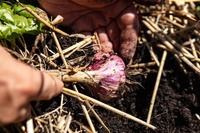
What would we do without garlic? This Mediterranean staple adds delicious flavour to a whole range of dishes, from soups and stews to stir-fries and casseroles. It's also easy to grow, and a wide range of varieties is available. Plant your own garlic cloves this autumn, and you can enjoy harvesting and cooking with your own home-grown garlic next summer!
Types of garlic
Garlic is divided into hardneck and softneck varieties.
- Hardneck garlic produces flower spikes, known as 'scapes,' which are generally cut off before they can flower. Hardneck garlic is hardier and better for cold areas and tends to have more complex flavours.
- Softnecks do not produce scapes, so the necks of the bulbs stay soft. Softnecks do well in areas with mild winters and store better for longer.
The garlic sold in supermarkets is usually softneck garlic.
Popular hardneck garlic varieties include Garlic' Kingsland Wight', 'Caulk Wight' and 'Sprint', while Garlic' Solent Wight', 'Messidrome' and 'Germidour' are all excellent softneck garlic.
How to plant garlic
Garlic needs well-drained, fertile soil in a sunny spot. It is best planted in autumn to give it a long growing season, but some garlic varieties can also be planted in spring.
- Before planting, dig in plenty of organic material, such as compost, and add grit to improve drainage if necessary. Remove all weeds and large stones, and rake a general-purpose fertiliser into the soil.
- Plant individual garlic cloves 15cm apart and 2.5cm deep with the tips just below the surface of the soil, pointing upwards. Water after planting to settle the soil.
- Cover the beds with cloches or fleece to stop birds from pulling up the young seedlings.
How to care for garlic
Garlic is generally trouble-free and doesn't need much looking after. Follow these tips for a healthy crop.
-
Keep the beds clear of weeds. It's best to weed by hand to avoid damaging the plant's shallow roots.
-
Water well during long dry periods. When the leaves start to turn yellow, stop watering.
-
If scapes appear, pick them before they flower so that the plant's energies are focused on developing large bulbs. The scapes are delicious sauteed or roasted!
-
When the leaves are yellow, the bulbs are ready to harvest. Lift them gently using a garden fork. Spread them out in the sun or inside a well-ventilated room and leave them to dry for 2-3 weeks until the skins are papery.
-
Once the bulbs are dry, remove any damaged or bruised ones and store the rest in a string bag in a cool dark place.
Wondering what to plant in your vegetable garden this autumn? We have a great range of seeds, bulbs and plants in our centre to keep your garden looking good all year round!

